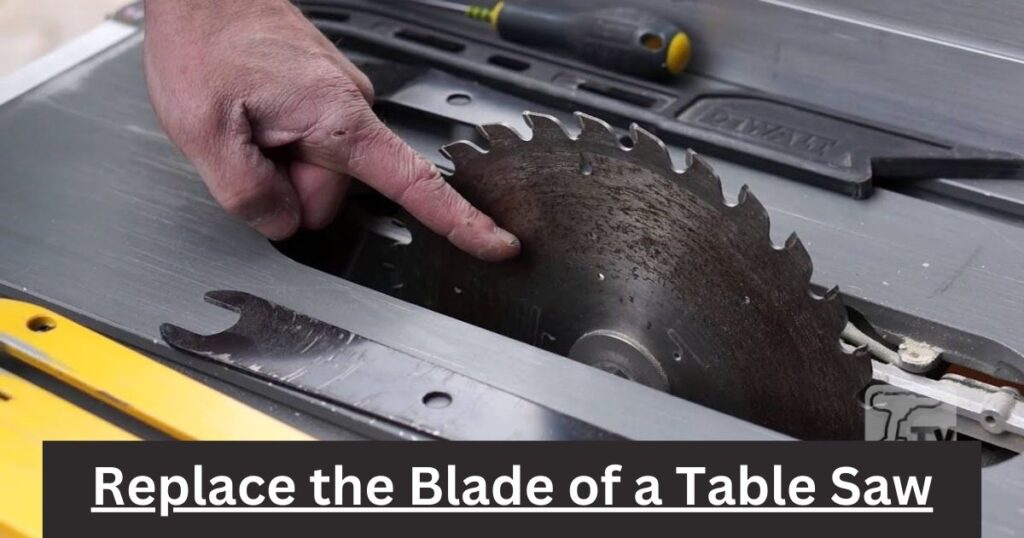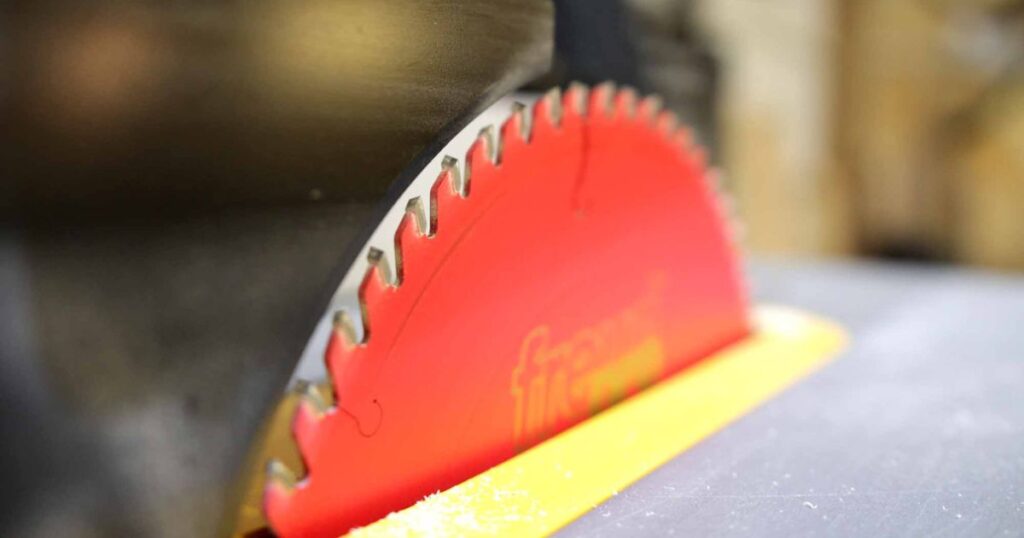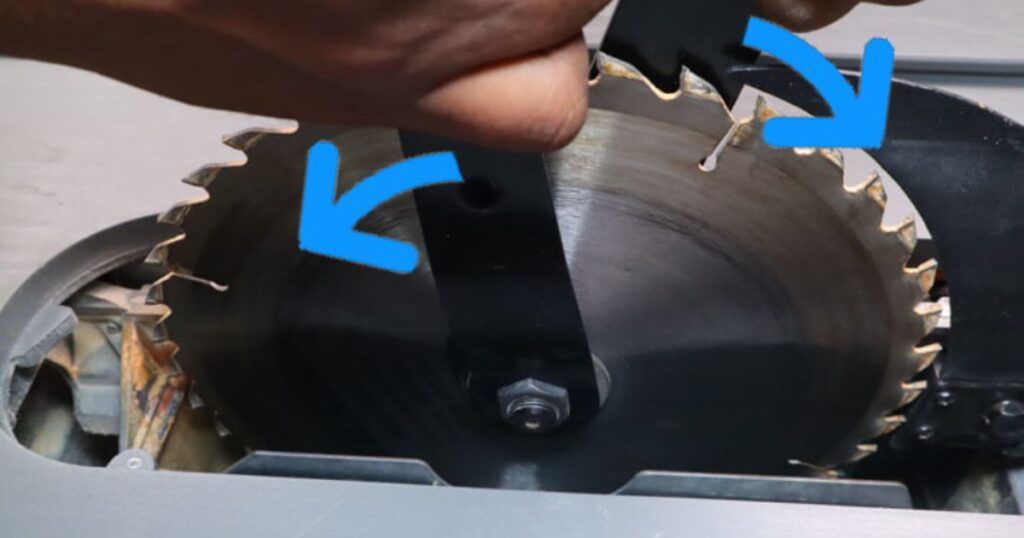You should use your table saw the most if you have one because it is one of the best tools for cutting wood. Also, you should always know what kind of saw blade you want to buy. But are table saw blades reverse threaded.
Most table saw blades have threads that are twisted around. It means that the blades on the table saw go in the opposite direction of each other. But there is one catch. If you want to reverse-thread a table saw blade, tilt it to the right. Blades that lean to the left are not spun backward.
But it’s always important to know exactly how the blades of a table saw are attached. This will help you when you need to change, tighten, or remove the blades.
Let’s learn more about blades and table saws.
What Does Reverse Threaded Mean?
So, to sum up, “Threaded” means to connect the blade to the saw well. When a spindle is reverse threaded, the thread turns in the opposite way of how it normally does. While the thread unwinds counterclockwise, the needle turns in a clockwise direction.
Still, you have to tighten your bolt reverse threaded when you turn it counter-clockwise. This is also what circular saws do. This is why circle saw blades can be used on any table saw. Any right-handed saw can’t have its threads turned around. This won’t reverse thread when a saw blade moves to the left.
Why is It So Important that the Blades of the Table Saw Have Reverse Threads?
There’s no question that cutting wood with a table saw works well. At the same time, though, it can be dangerous to use if you’re not careful. On the other hand, the saw blades must change thread. Why, though?
You should already know what the reverse line means, right?
Every blade that you put on the saw spins in a certain way. Most of the time, the blades move forward and spin. The blades of the table saw are also attached to an arbor. An arbor holds the blade in place, kind of like a shaft.
A nut is also useful because it makes sure that the stem is securely attached to the blades.
Even so, the arbor nut needs to turn the other way from the blade for all the right reasons. This means the nut is more likely to turn away from the blade if the blade goes toward the front of the table saw.
Also, the blade of the table saw needs to move toward the front of the table in a clockwise direction. To make it reverse-threaded, you have to put the blade on the right side of the table.
But if the nut turns with the blades, the nut could come loose and crash badly. Simply put, who knows?
How to Replace the Blade of a Table Saw:

Your table saw’s blade might need to be changed at any time. To begin, you should know the right way to change a table saw blade. This is important because it will go horribly wrong if you don’t put the blade incorrectly.
Changing the blade on a table saw, on the other hand, is not at all hard to do. This can be done by anyone who knows the basics.
Need something to take off the table saw blade?
In this case, the table saw blade wrench comes in handy.
Let’s switch out the table saw blade.
Step 1) Disconnect the Saw:
This is the first job that needs to be done. It would help if you turned off the power to the saw before changing the blade. Do you really want to put your hand on the table saw blade?
Step 2) Remove the Pharynx Plate:
To get to the blade better, it would help if you took off the table saw’s throat plate. Then use your hand to pull it out.
Step 3) Get the Riving Knife:
A riving knife is used to keep the saw safe in most stable saws. This is behind the saw blade. Take it out. Also, remember to put it back in place when you’re done changing the blade.
Step 4) Take Off the Nut with an Arbor Wrench:
An arbor (a piece of wood) holds the blade in place on the table saw. To get the blade out, you have to take off the nut. If the arbor goes into the blade from the right side of the saw, use a wrench to turn the nut into the teeth of the blade.
Put pressure on the blade with a stick or something similar to keep it from moving while you take off the nut.
How do we change the blade on my table saw without an arbor wrench? This is the question that most people have. In this case, you can use another flexible wrench.
Step 5) Switch Out the Blade:
After you’ve done the things above, you can put in another blade. After putting the new blade on the table saw, make sure you do the same thing again.
Selecting an Appropriate Blade:
You will progress through various undertakings by acquiring knowledge of the proper saws for each task. There are four blades that require your attention:
For Flat Top Grind (FTG):
FTG blades cut quickly through the wood by cutting across the grain. The rakers on FTG blades let them cut through wood. The sides of the rakers are square, and they are blade teeth. It’s not perfect, but FTG blades are great for cutting out big pieces of wood.
Alternative Top Bevel (ATB):
Because they are so flexible, ATB blades are often called “all-purpose” blades. Since the teeth don’t all point in the same direction, they can work at different angles. The blade’s teeth, on the other hand, switch places. But there is a catch: the blade dulls quickly but cuts well at sharp angles.
Combination (ATBR):
The Combination (ATBR) blade has traits of both the FTG and ATB blades. ATBR blades have 50 bare teeth, four ATB teeth, and one raker after every five teeth. While the rakers tear the wood, the ATB teeth make clean cuts across it. Their teeth can do many things, which makes them great “all-purpose” blades.
Triple Chip Grind (TCG):
TCG blades can cut through materials that are too heavy and thick for ATB, ATBR, or even FTG blades. Plastic laminate, brass, and aluminum are just a few of these products. Teeth in the TCG switch between chamfered and raker teeth. They make the cut rough so that the raker can smooth it out.
It’s important to note that the blade’s teeth make a big difference. The hook, or rake, of the teeth, is what makes the blade good or bad. A “hook” is the angle between the teeth and the middle of the blade.
When feeding the wood piece, higher curves need less force. Blades that can be used for many things, like ATB and ATBR, usually have a hook that is 15° to 20°. Some blades have an edge that is either zero or negative degrees to stop them from self-feeding.
The best blades for cutting thin materials are ATB blades. Denser materials can also be cut with ATB blades, but they are hard on the teeth. TCG blades should be used on high-density materials like plastic laminate.
How To Use Your Reverse Threaded Table Saw Blades:

- To begin, you should loosen the saw’s blade and throat plate and take them off.
- Then raise the blade higher and bring a level piece of wood closer to it. Then you need to make changes to the wrench.
- When you turn the blade, the bearing piece will fix it so that the blade stays steady.
- When you set it up, be careful.
- Make sure you don’t loosen the blades. Remember to keep the blades as tight as possible if you want to work backward.
- You should be extra careful because you could hurt yourself.
- Then you’ll have to take care of the blade to keep it safe.
- It’s annoying for life to have to stop and check on the blade’s state.
How to Make Your Table Saw Blade Tighter:
To make a safe point, unplug your saw before you turn off the blade. The motor of the blade should not be plugged in because it could hurt you. Then you’ll need a wrench to make changes to your saw stand.
You could still hurt yourself if you hold the blade with your bare hands. Most of the time, We tell people not to hold it that way. If you lose a hand on the grip of your blade, it could become much weaker and lead to an accident.
When you turn your point, the saw blade goes forward, which could hurt your champers. So, stop the process as soon as the machine makes a sound. After that, take the locking device off. As soon as the method is over, you can start the tightening process.
Procedure for Tightening:
To make the blade tighter, you must first safely remove the plastic part at the top of your saw with a wrench. Then, use your wrench to lock your saw blade in place. To lock the blade in place, hold the wrench on it.
What is the Way to Turn the Nut?
This is how you should take care of your nut. If you don’t pay attention to this number while it’s being used, you can also damage the bolt with a saw because the blade will turn. Because of this, your saw blade might come loose, and rust might happen.
Before you can turn the nut with the pointed saw, you need to stretch it to free it. If you don’t take care of your saw blade, you shouldn’t use it. Using that blade could lead to a disaster.
Now that you’ve made sure the saw blade is properly set, you need to test it by spinning it.
How Do You Get the Table Saw Blade Loose?

It doesn’t really matter how tight or loose the blade is. You will need to rest on the operator’s side because you need to open the saw and take off the blade guard. So that the blade doesn’t turn, you must first hold the working flange with your wrench and then use another wrench to unscrew it.
Check the nut to see if it can be loosened to your liking. You should turn the bolt that is connected to the blade to loosen it. When the filament is wrapped, a saw winding that is going in the right way turns to the right. You should also check the state of the nut when the wrap happens.
Awareness:
A lot of woodworkers make the mistake of using toothed saws every year. They hurt themselves because they don’t know they’re hurt. To follow safety rules, use the right-angled table saw with highly threaded blades. Watch out for the depth of your cut, because anything could go wrong.
The Necessity To Be Well-Informed Regarding Each Component:
You should know every part of every saw from top to bottom. You should know about the unique applications. Find out the basics. During moves, people often get hurt, so try to be more careful.
Bottom Line: Are Table Saw Blades Reverse Threaded
This piece has the answer for you. You can make your table’s blades a backward thread, though, if they aren’t already one.
Also, be careful and don’t try anything fancy when you change the blade on the table saw. Select the correct blade so you don’t have to change it too often. Besides that, you should know how to use certain tools. It’s easy to rip things with FTG blades.
ATB and ATBR blades, on the other hand, can be used for many things and cut through things strongly. For high-density materials, look at TCG blades. Finally, once you’ve picked out your blade, follow the steps above to safely place it. We hope you enjoy the table saw a lot.
FAQs about Are Table Saw Blades Reverse Threaded
Are Saw Blades Turned Backward?
It varies based on which saw blade is in place. If it’s on the left, the bolt is threaded backward, so you need to turn it to the right to free it. The lefty-loosey works as well if the blade is on the right.
In What Direction Does a Table Saw Blade Come Loose?
Take off the arbor nut that is keeping the blade in place with the blade wrench. Turn the wrench in the same way that the blade cuts to loosen the nut. Pull back the saw’s top blade guard and take off the old blade. Before you put the new blade on the saw, make sure that the saw teeth face the direction of movement.
What Occurs When a Saw Blade is Inserted in Reverse?
It’s possible to cut with a saw blade turned around. But that’s not at all a good idea. Two main reasons why you shouldn’t do this are that saw tips are more likely to break off and the saw blade itself is more likely to come apart if it is run backwards.
Related Posts:
- How to Crosscut Plywood on a Table Saw
- Arbor Saw vs Table Saw
- Craftsman vs Ryobi Table Saw:
- Best Table Saw For Hobbyist
- Best Table Saw Under $2000
- Best Table Saw for Furniture Making?
- Table Saw vs Band Saw: Which One Is Better?
- What Causes Kickback On a Table Saw?
- Can a Track Saw Replace a Table Saw?
